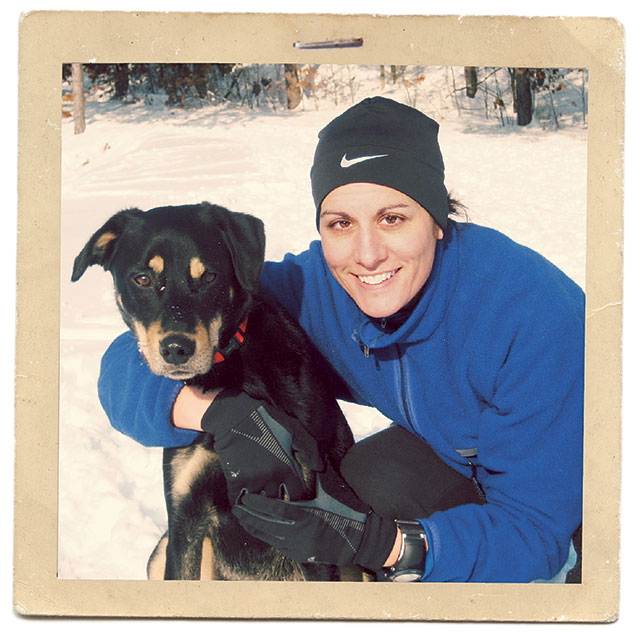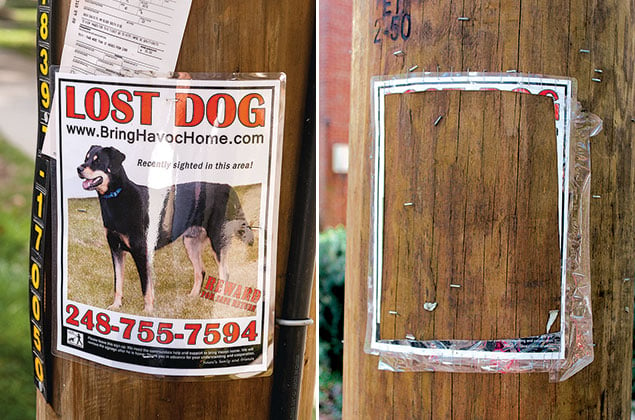One Sunday afternoon this past August, right after Congress has gone home for recess, a small rowhouse in Georgetown is buzzing. Volunteers whir around the living room, pouring paper cups of wine, cramming into couches and a hastily assembled collection of folding chairs. Normally, these canvassers might be here to pick up fliers from the war room downstairs, but today they’re taking a reprieve from the streets to strategize. There’s no time for the usual Washington summer slumber: November is pressing in.
They’re not, alas, running an electoral campaign. Rather, the month will mark the one-year anniversary of the disappearance of a dog named Havoc. Last November 9, the Lab/rottweiler mix with a bushy tail and a fear of cats chased a deer through a hole in the fence surrounding Northwest DC’s Dalecarlia Reservoir. His owner, Janet Mihalyfi, hasn’t seen him since.
Though not for lack of trying.
Over the last year, Mihalyfi has overseen a messaging operation that might put the more traditional campaign strategist to shame. Building a cadre of volunteers worthy of an insurgent political candidate, she has door-knocked and blanketed the upper reaches of Northwest with urgent, in-your-face signage. She’s tapped her own bank account to fund 50,000 robo-calls, hire professional private-eye dogs, and confab with four psychics. And she’s pounded the pavement of the “Havoc Zone”—the swath where people claim they’ve spotted him, and where the tracking dogs have picked up his scent.

• • •
The effort has cost Mihalyfi $35,000 (and counting). And, like a good insurgency, it has also pissed off a lot of people.
See, lose your dog in DC’s wealthiest area and there’s inevitably going to be some First World-problem kinda tension between the people who have time on their hands to get indignant about lost-dog posters on their telephone poles and those with enough free time to look for someone else’s runaway pet.
Today, the 20 die-hards at Mihalyfi’s house are even more fired up than usual, thanks to two dramatic developments within the last week. First, a dog that looks like Havoc was caught conducting his business on one of the cameras Mihalyfi set up in Glover-Archbold Park.
Four days after that, volunteer Maureen Reese was combing the woods when a black-and-tan, rottweiler-type dog appeared ahead of her on the trail. Reese froze—something the tall, platinum-blond actress excels at, thanks to playing “living statues” of Greek goddesses and the Statue of Liberty at parties—but as quickly as the dog materialized, he withdrew into the trees.
“It was like seeing Nessie come out of the lake,” she says.
With that, Mihalyfi and her army—scraping up against what many would see as the outer limits of actuarial logic, public goodwill, and psychological soundness—got another jolt of the thing that keeps their mission going: hope.
“I have people who say Janet’s delusional, that she’s crazy,” whispers a 40ish nanny named Jennifer, who calls herself an “animal fanatic” but won’t give her last name. “I can’t wait till we find him, so I can say, ‘F— you.’ ”
• • •
Mihalyfi was senior-class president at her high school outside Detroit. She graduated from the University of Michigan with a degree in chemical engineering. She has a director-level job at a consulting firm. She’s nobody’s idea of a lunatic.
Yet she hasn’t had a good night’s rest since Havoc left her. She devotes nearly every weekend and generally two to four hours each workday to her pursuit. Never mind the NIMBYs of Northwest—her own parents prod her to give up.
“There aren’t a lot of people who would go this long and spend this much,” Mihalyfi says. But quitting? Not an option. “I mean, I’m exhausted,” she says, face crumpling, tears spilling. “I love him to death, so there’s no end for me.”
Mihalyfi grew up with pets but never had her own until 2009 when she and her then boyfriend adopted two puppies from a rescue group. Their names: Wreak and Havoc. When the dogs were a year and a half old, Wreak was hit by a car and killed. Mihalyfi adopted a new dog, Raze.
A few years after that, Mihalyfi was child-free and newly single, in her late thirties, and ready for a change of scenery. Her employer was expanding its Washington business, so she made the move from Boston. Havoc absconded just four months after she arrived in DC.
It was early in the morning, and Mihalyfi was out on a run, speeding with Havoc and Raze toward the Dalecarlia. They arrived at a stream, and she let them off their leashes—something she did often—to get a drink. But then the deer showed up. And that was that.
Raze returned within minutes of bolting after the animal. Havoc did not.
Mihalyfi called her sister in Boston and instructed her to research lost-pet trackers. She phoned the ex-boyfriend, now in Sweden, and directed him to get the word out to Washington animal shelters. Within the first couple of weeks, he also built the website Bring Havoc Home, now the information hub for outsiders interested in the search and the latest sightings. (The site advertises an unspecified reward. “If they said they wanted a hundred grand,” says Mihalyfi, “I’d find a way.”)
She printed posters, began knocking on doors, and dropped fliers in Spring Valley, American University Park, and Bethesda’s Westmoreland Hills. As a newcomer, Mihalyfi knew almost no one outside her office. So the signs also served to recruit many of her earliest volunteers. “People are so kind here,” she says, then pauses, mulling what just came out of her mouth. “Well, that’s not entirely true.”

• • •
Within 48 hours of Havoc’s disappearance, Mihalyfi had a tracking dog on the case. They started at the reservoir and followed what the dog’s handler claimed was Havoc’s scent. But after six hours, the handler concluded the pooch had been picked up by a car and driven away.
Mihalyfi wasn’t so easily put off. She drove to dozens of animal shelters and vets within a two-hour radius of the spot where the tracker said Havoc was carted off. Have you seen Havoc? Have you seen Havoc? Have you seen Havoc?
No one had seen Havoc.
Mihalyfi alerted the Washington Humane Society, where chief humane law-enforcement officer Zita Macinanti mobilized her team. “All of us at one point or another have had boots on the ground,” says Macinanti. Most important, she directed Mihalyfi to a new lost-pet tracking company, whose past successes she could vouch for.
On the day of Mihalyfi’s first meeting with this new handler and her three dogs, Mihalyfi brought along her “most prized possession,” Havoc’s old collar, now triple-bagged in Ziplocs. Sure enough, after another six hours of noses to the ground, these canine sleuths concluded that Havoc was still nearby. He had left his scent behind at Massachusetts and University avenues—right where a tipster had recently reported seeing him.
This was good. The handler recommended critter cams: heat-and-motion-activated gadgets typically used by hunters to snap wildlife. Mihalyfi ordered a bundle through Amazon and secured them to trees throughout the woods of the Havoc Zone. She assembled feeding stations of kibble and angled the cameras downward, toward Havoc height. (Of course, at least some human passersby get captured: A volunteer reviewing the memory card from one of the cameras once spied a “big, wide ass” that looked as if it belonged to one of DC’s finest taking a leak on a tree.)
For a time, Mihalyfi also used a trap from the Humane Society—but it was only good at catching foxes and raccoons. After three weeks, she felt terrible about the whole thing and returned it.
Back in the human-populated part of the Havoc Zone, Mihalyfi enlisted LostMyDoggie.com, a company that broadcasts missing-pet alerts. Its robo-calls are no less annoying than the ones from politicians. “They call four times until someone picks up,” Mihalyfi explains. She says she got “some pretty nasty calls” from miffed neighbors.
All the while, the universe of volunteers was growing—Mihalyfi estimates there are 2,000 supporters, though that number includes both hardcore Havoc hunters and people who receive regular e-mail updates. Some of the volunteers approached her after spotting her car, which is decorated with huge LOST DOG! posters. One neighbor built her four two-by-three-foot wooden sandwich boards for strategic positioning at high-traffic spots.
But by then, the backlash was under way. On Christmas Eve, the sandwich board near the Crate & Barrel on Massachusetts Avenue in Spring Valley went missing. Mihalyfi replaced it. The next day—Christmas!—someone filched it again.
The sandwich boards had cost close to $100 apiece, which was aggravating. But frankly, she was more offended knowing how much trouble her neighbor had gone to in making them.
• • •
And that is why, two nights after Christmas, Mihalyfi found herself staking out the latest board to go up. She says she was prepared to stay all night. As it turned out, she didn’t have to. Forty-five minutes in, a man in a truck pulled up, got out, and strolled over to the sign. “Oh, my gosh—I think this is going down!” Mihalyfi remembers telling a volunteer who had happened onto the scene.
The volunteer confronted the culprit. Mihalyfi dialed 911. Suddenly self-conscious about calling in the theft of a lost-dog sign, she chose her words carefully. “I’m witnessing a robbery in progress,” she remembers reporting. “My personal property is being stolen.”
Spooked by the Havoc volunteer, the thief was already hurrying back to his truck, sign in hand, on the verge of getting away as Mihalyfi sat there running down the info with 911. She threw her car into drive. “Ma’am, do not chase this person!” the operator ordered.
Mihalyfi sped up side streets around Mass. Ave. anyway. “Go back to where you were!” the operator yelled. “Officers are on their way.”
“I’m really sorry,” Mihalyfi replied. “I gotta chase this guy.”
She hung up.
Mihalyfi tailed the truck through Spring Valley, then into Bethesda, where the man turned, pulled into an abandoned construction site, and came to a stop. Was he daring her to follow? Mihalyfi decided to turn back toward DC. Then two headlights lit up her rearview mirror. The truck.
She dialed Kevin Brittingham, a DC police officer. They had met not that long before, after she reported a different man ripping down signs and harassing her volunteers. Soon Brittingham counted as one of her 2,000 supporters. One time, near American University, he spotted a man walking a dog that he swore was Havoc. “I jumped out on the dude,” says Brittingham. “I mean, not to the point where I wrestled him down, but I went running over. The dude was definitely scared.” The dog, though, wasn’t Havoc.
Brittingham advised Mihalyfi to return to the crime scene and meet up with police. “Janet, be careful,” he added. “There are a bunch of crazy people out in the world.”
Mihalyfi did as she was told. And arrived to find two young policemen swarmed by four women who could have been their mothers. Her volunteers from the neighborhood.
Authorities eventually tracked down the thief at home. It turned out, Mihalyfi says, that he wasn’t one of the run-of-the-mill Havoc foes. “He thought his name was Havoc, so he was really upset that there were so many signs being put up about him.”

• • •
America loves its pets. According to the American Pet Products Association, we’ll spend more than $58 billion on the animals this year. Washingtonians have their pick of “yappy hours,” pet spas, and other luxuries—like the “custom bed” and turndown service with treats at the W Hotel.
All the same, in Mihalyfi’s case, the population of those who roll their eyes at her seemingly doomed effort includes at least some self-described dog lovers. Scott Polk, a board member of a citizens’ group for Foxhall Village, a picturesque enclave of million-dollar-plus Tudors, owned two Welsh terriers before they had to be put to sleep a year apart—“It’s still painful,” he says—yet he says he and his neighbors are sick of all the LOST DOG! paraphernalia cluttering their streets.
“It’s time for her to get a life and move on,” he says. “You have to wonder if people think the dog just wants to get away from her.” He laughs, then seems to remember he’s on the record talking about a lost rottweiler and tries to backpedal.
Mihalyfi finds these kinds of comments hurtful, but she’s not surprised by them (anymore). For someone who’s so single-minded, she’s also self-aware—limiting the Havoc talk at work, using disclaimers like “I’m sorry, I know I’m a mess.” Plus, the opposition only seems to rally her supporters. “It’s not gonna break us, that’s for sure,” says volunteer Allison Wilner Melrod.
Mihalyfi has also become savvy enough to know that a little mud slung her way can make for good PR. In February, for example, the local news site Bethesda Now published an article about her, triggered by an anonymous complaint that read in part:
Can anything be done to put a stop to the constant postering of missing dog, Havoc? . . . While I’m sure most everyone sympathetically wants this individual to find her dog, this assault/nuisance has been going on since November, with posters covering just about every surface.
Local TV stations picked up the story, as did AOL. Then Inside Edition dispatched a correspondent to Mihalyfi’s house for a tearful interview. Although she says that brought out “all the sickos”—people saying they had Havoc and would cut him into pieces and send them to her, people sending her pictures of dead dogs, people calling from jail—it also attracted new fans. “All of a sudden, my in-box had just hundreds of e-mails,” she says. Right when she needed a boost.
Washington was in the midst of one of its harshest winters on record. The trek to the eight critter cameras took her four frigid hours a day. Though the tracking dogs were still at work—they continued picking up Havoc’s scent, Mihalyfi says—fewer tipsters were reporting sightings. During a brutal cold snap, she had to force herself to consider what she calls—and she can’t bring herself to say it without crying—“a dead-dog scenario.”
Lost Your Dog?
These resources, including some used in the Havoc search, might help
ASPCA and the Humane Society of the United States. The organizations’ web-sites include tips for finding pets.
The Center for Lost Pets. An online hub where people who have lost pets or found loose animals can connect.
Lost My Doggie. A robo-calling service that broadcasts lost-pet alerts to your neighbors.
Lost Pet Professionals. Private investigators and tracking dogs for hire.
One subfreezing morning around 5 am, Mihalyfi was en route to a critter cam, straining to see in the dark, when she heard the thwack of shattering ice and found herself thigh-deep in a frozen stream.
Washington eventually thawed, and the tracking dogs continued finding Havoc’s scent around AU Park. Until March, that is, when they traced him to Glover-Archbold, 221 acres of forest southwest of Rock Creek Park. This was totally new territory for Havoc and a few minutes farther from Mihalyfi’s home in the Palisades. She saw only one option: move.
When she met with prospective landlords Arvind and Connie Deshpande in Georgetown, they noticed a Havoc poster in her bag. Mihalyfi explained that she was the woman behind all the signs they’d seen in their neighborhood. The Deshpandes said they’d be happy to rent her their rowhouse. And take over one of her critter cameras.
• • •
One afternoon about a month after I met Mihalyfi, I got on the phone with Robyn Zeiger, a therapist in Silver Spring who counts pet bereavement among her specialties.
“Everybody grieves differently,” Zeiger explained. “I guess what I look at is functioning. If somebody’s at a point that it really gets in the way of functioning, then how healthy is that?”
Good question. Mihalyfi would be the first to tell you she’s got no life outside the Havoc campaign. But it’s not as if she’s stopped eating or brushing her teeth. She carries on because she can’t quit Havoc or her movement. At this point, how could she? “In some sense,” she says, “you have to feed the volunteers. You have to keep the morale up.”
In August, right after Mihalyfi got word that Havoc may have been caught on camera in Glover-Archbold Park, her followers came up with the idea to hold a grill fest. On day one, I went along. The whiff of burning charcoal at the corner of 42nd and Beecher streets led me into the woods right to Sarah Webster, a bleached-blond Jersey Shore native covered in tattoos and wearing short shorts. A small table held a slab of meat double the size of a football—a pork shoulder, Webster explained, as she kept an eye on the bone marrow smoking on the grill. The idea was to attract Havoc back to the area with the aroma of cooking flesh.
Webster, who is among the hardcore crew of volunteers Mihalyfi calls her “MVPs,” handles one of the most notorious poster routes, along 44th Street in Wesley Heights. “As fast as I put those posters up, they get taken down,” says the 37-year-old editor of a US Coast Guard publication.
She’s tried nearly everything, such as standing on a barstool to hoist ’em high and out of reach. Once, she staple-gunned the entire border of a poster and returned to find the whole middle of it knifed out.
Webster suspects her saboteurs are afraid to approach her because she looks a little tougher than her fellow canvassers. But another MVP, Melrod, who used to be married to a real-estate investor and resembles an older Kristin Chenoweth, says she’s been screamed at.
A week of grilling went by and Havoc was still at large. So Mihalyfi called the August meeting in Georgetown.
It starts with the bad news: Maureen Reese, the Greek-goddess statue who was so hopeful she saw “Nessie,” actually encountered one of four Havoc look-alikes that Mihalyfi ID’d as living in the neighborhoods near the park. But, as has happened throughout the Havoc havoc, the gut punch still serves as a motivator. Pretty soon the assembled are batting around new ideas.
Jennifer, the nanny with the sailor mouth, wonders whether the posters’ design should be updated so people know they’re new and (maybe?) won’t rip them down. Webster has brought photos from her Air Force days showing a tent-like structure made of sticks that the group can adapt for a shelter to lure Havoc. “We could hide it,” she says, “put foliage on it, and camouflage it.”
But the most promising new lead may be the big steaming clue the dog caught on camera left behind. (Mihalyfi has already found a lab where she can send the droppings for DNA testing.) As she projects the photos of the dog onto her living-room wall, a debate breaks out over “pooping positions.” The volunteers—who now have a nearly life-size view of the squatting animal—want to know if Mihalyfi can tell from the crouch whether it’s Havoc’s.
“Zsa Zsa has a high stance,” offers Penelope Brown, a dog trainer with graying hair and wire-rimmed glasses, using her own pet as an example.
The women study the images for a couple of minutes, comparing them to photos of Havoc, also blown up on the wall.
“The snout is dead-on,” says Jennifer.
The tail, though—something’s off. Isn’t Havoc’s much bushier? Doubt creeps into the room.

• • •
The e-mail Mihalyfi dreaded arrives the next day. It’s from the owner of one of the Havoc doppelgängers, who’s had a chance to inspect the images. She confirms that her dog was near the camera when they were taken. She’s certain the animal caught mid-squat was hers.
Mihalyfi allows herself a couple of hours for a good cry before sharing the news with her supporters and manages to end the e-mail on a positive note: “I got a sighting last night of Havoc crossing Foxhall Rd at 2:00 that I believe was him.”
Hang around long enough with Mihalyfi and you start to feel some hope yourself. Not long afterward, she and I are in the park together, checking the critter cams as Raze darts in and out of the trees. Despite what happened with Havoc, Mihalyfi still lets the dog off leash. She just straps a GPS collar around the animal’s neck.
We’ve been searching 20 minutes at most when I look to my right and see Raze just a short distance off the path, then glance to the left toward a creek, not an unlikely spot to find Havoc, as it’s a water source, at least according to Mihalyfi. I turn my gaze back straight ahead and feel my stomach lurch. Nessie.
A black-and-tan dog stands maybe 15 yards in front of me.
“Janet, that dog!” I gasp.
“Oh, it’s just Raze,” she says, laughing.
And so it goes. Five days later, I finally get ahold of Diane Roadcap, one of the four animal psychics Mihalyfi has consulted, and the most convincing because she knew things about Mihalyfi’s past that “not even her family knows.”
Roadcap, who sees 25 to 30 clients a week and charges $250 to $350 a session, says that when she met Mihalyfi last winter, she could feel Havoc’s fear and sensed he’d been wandering in a circle. But then she drops the bomb—things have changed: “At this point, I feel he has been picked up. He’s been relocated toward Dulles Greenway, out toward Leesburg.”
Since spring, Roadcap goes on, Havoc has been living the good life on three to five acres with a family, a golden retriever, and an elderly schnauzer mix. “He’s loved and well taken care of,” she tells me. “I sense his joy. I see it in my third eye.”
I immediately text-message Mihalyfi to tell her about Roadcap’s vision. She’s skeptical because it contradicts the tracking dogs’ findings that he remains in Glover-Archbold and has also begun roaming into Rock Creek Park. “Some of the tracking is just so precise,” she says.
Well, maybe. But this vision of Havoc, romping out in the country, getting a huge kick out of all the havoc he’s created—it’s nice to imagine, isn’t it?
This article appears in the November 2014 issue of Washingtonian.



















